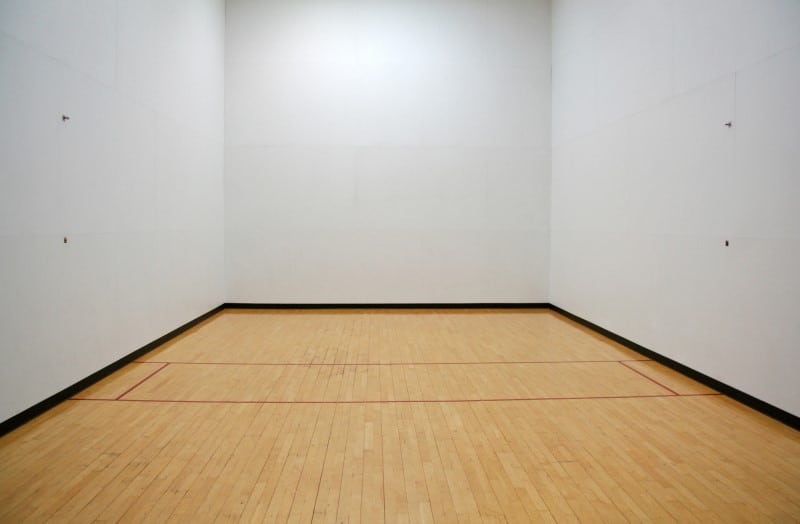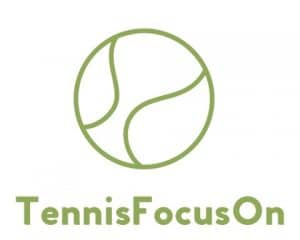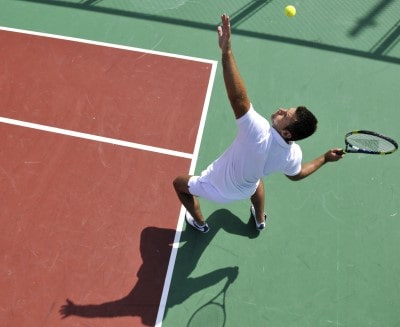Not all of us may have the time to get to a proper tennis court to practice. Sometimes life gets in the way. But that does not mean we are completely out of options. Tennis players can get some good practice in various ways—not just on the tennis court. One such place may be the racquetball court.
So can you practice tennis in a racquetball court? You can practice tennis in a racquetball court. However, a racquetball court is smaller than a tennis court, which will limit your ability to practice efficiently. By practicing tennis in a racquetball court you can damage the walls, so it is best to stick with open racquetball courts with concrete walls.
Below you will find a more in-depth breakdown of the pros and cons of using a racquetball court for tennis practice, including some extra information and tips.

Can a Racquetball Court Be Used for Tennis Practice?
A racquetball court can be used for tennis practice. However, the main problem stems from the fact that there is a huge difference in the playable area, which will be available to you.
Racquetball courts are mostly situated indoors because both the walls and the ceiling are playable areas. However, there are also outdoor racquetball courts that are half enclosed, which may be a better alternative for tennis practice.
A tennis court is 78 feet long and 27 feet wide (36 feet for doubles). In comparison a racquetball court is fairly smaller. It is 40 feet long, 20 feet wide, and 20 feet high.
You can already see, judging by the numbers, that a tennis player will feel very limited in terms of movement. Width-wise, the difference is just 7 feet, which can be overlooked. However, the main problems come from the fact that racquetball courts are very short—nearly half the length of a tennis court.
The flooring of racquetball courts is usually made with laminated wood. It will feel a lot different compared to most tennis courts. The ball will bounce a little differently, but overall you should not stumble upon any significant inconveniences here.
Conversely, the side effect of that is that you can work on your footwork for hard courts, but may not be transferable to grass or clay.
So while a normal tennis match practice and full swings may be out of the question, you can still use the walls in the racquetball court.
Practicing against a wall is an excellent way to work on your footwork, technique, and shots. As a matter of fact, you can practice every single type of shot that you will do in a real match.
When practicing tennis on a wall, most players prefer to have a horizontal line across the wall, which corresponds to the tennis court net. In addition to the horizontal line, a good rule of the thumb is to have a square drawn in the center of the wall, which is used as a target. The reason I am mentioning this is that these small details are useful to make your practice sessions a lot more focused, structured, and productive.
The problem with racquetball courts is that they do not have any markings on the wall, and the chances are you will not be allowed to draw on the wall.
Depending on how lenient the owners of the racquetball court are, it may be possible to use masking tape since it is very easy on the walls and does not leave any adhesive after being removed.
It is worth mentioning that some places may not allow you to practice. Practicing tennis on a racquetball court may not be good for the walls. If you are training on some of the open racquetball courts made from concrete, then there is nothing to worry about. However, some walls are made from different types of wood, which is soft and can be easily damaged by tennis balls.
Is It Worth Practicing Tennis on a Racquetball Court?
Racquetball court fees range between $10 to $40 per hour and $400 to $800 for an annual membership.
It all comes down to the return on investment you can get.
You already know that you can practice on a racquetball court as long as you are ready to make certain sacrifices. You can practice your forehand, backhand, slashes, volleys, etc. So it is a decent place to learn and work on your shots. However, you are limited in terms of the playable area, which is available to you, and, in addition, you will not be able to do any full swing, powerful shorts (you can actually even damage the walls by doing that).
On the other hand, a smaller court may develop your reflexes and reaction time.
Truth be told, you can get the same, if not even better, practice by hitting on a wall. Some pro players are well known to squeeze a wall practice session whenever possible, like Monica Seles, for example.
A wall can be an excellent tool to work on your footing, technique, hits, and so much more. Best of all, you can do it anywhere where you may have access to a large enough free space and a wall. Many dart players even use their garage doors for that, although I would not recommend it.
Overall, practicing on a wall is usually cheaper than a racquetball court and can provide the same if not better benefits.
Racquetball Court vs. Squash Court
Some topics have definitely ruffled a lot of feathers. And this happens to be one of these topics. However, I am not going to be talking about which one is better; rather, I want to focus on something different.
A squash court can also be used for practicing tennis. There are some differences, though.
Is There a Difference Between a Racquetball Court and a Squash Court?
Both the racquetball court and squash court are very similar in the way they are set up.
Without going into too much detail, the main difference lies in the size of the two courts.
Squash courts measure 32 by 21 feet, and racquetball courts are 40 by 20 feet. The playable height is also different, with racquetball courts being slightly higher measuring at 20 feet and squash courts being 15 feet high.
The surface of the two courts is also different, and there are other minor differences in the boundary lines.
Is a Squash Court Better Than a Racquetball Court for Tennis Practice?
As you can see, squash courts are significantly smaller but wider.
Pro tennis players are usually very high, so if we take an average of about 6 feet, add a little over 2 feet for the racquet and take into account the feet or so players jump when serving, we can end up with 9 to 10 feet in total. The limited height of the squash court can make tennis players feel somewhat restricted, and some high balls and jumps may definitely be a problem.
Judging by that, a squash court will not necessarily be better than a racquetball court. But if you only have access to a squash court, then, absolutely, it can be used for tennis practice.
Squash courts usually have some markings on the wall, with the most notable being the service line, which is a horizontal line marking the minimum height of the service in squash. However, it is usually about 5.8 to 6 feet off the ground, so it cannot be used as a substitute to the tennis court net, which is usually about 3 feet 6 inches high.
Does Practicing Racquetball Help With Tennis?
Okay. So maybe, for some reason, you are not allowed to practice tennis at your local racquetball court. And you do not have access to a tennis court. Maybe it is too cold, and there are no indoor tennis courts in your area.
The only option is to practice racquetball. But you are worried. Will this be a good idea, and what will be the carryover to tennis?
For a long time, it has been believed that practicing racquetball (or squash) will hinder one’s abilities to play tennis. But there are also people who believe this to be nothing more than a simple myth.
Yes, racquetball is a different sport with different rules, and you need to understand the implications of that, but it will not necessarily interfere with your tennis game.
If you have to wait out the winter season, it will be a lot better if you continue to practice a racquet sport even if it is not tennis. In fact, many players even consider squash to be beneficial to tennis players. You can read more about How to Practice Tennis During Winter.
Any practice is better than no practice. The only bad practice is the one that didn’t happen or was done in bad form.
With that being said, you need to stay focused and use racquetball practice sessions in a smart way. Do not trade in your tennis techniques. Remember that this is just a practice session. You are not there to become a good racquetball or squash player.
In the short term practicing racquetball can be a good way to put in some practice.
Cross-training can give you a whole new perspective of the game. But the longer you play racquetball and the more used you get to the techniques (like the wrist snap), the more it will affect your tennis play.


